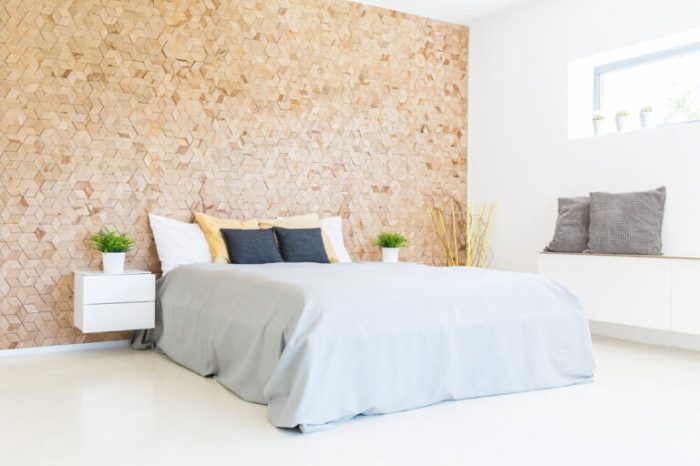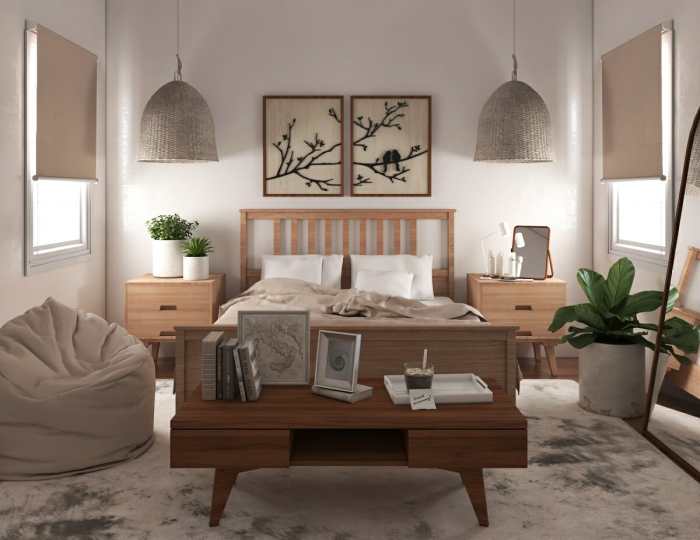In today’s environmentally conscious era, sustainable design has become an integral aspect of modern living. Extending this eco-friendly approach to our personal spaces, particularly our bedrooms, offers numerous benefits for both our well-being and the planet.
Sustainable bedroom design encompasses a holistic approach that considers the environmental impact of materials, furniture, and decor choices. By embracing eco-friendly practices, we can create a restful and rejuvenating sanctuary while minimizing our ecological footprint.
Eco-Friendly Materials for Sustainable Bedroom Design
Incorporating eco-friendly materials into bedroom design is crucial for creating a sustainable and healthy living space. These materials not only reduce environmental impact but also enhance the aesthetic appeal of the room.
Choosing certified and sustainable materials ensures their environmental credibility. Certifications such as Forest Stewardship Council (FSC) for wood and Global Organic Textile Standard (GOTS) for textiles guarantee responsible sourcing and production practices.
Organic Cotton
- Biodegradable and renewable, reducing landfill waste.
- Grown without harmful pesticides and fertilizers, promoting soil health.
- Soft, breathable, and hypoallergenic, providing a comfortable sleep experience.
Bamboo
- Rapidly renewable resource, reducing deforestation.
- Naturally antimicrobial and moisture-wicking, creating a healthy sleep environment.
- Durable and versatile, suitable for various bedroom furnishings.
Recycled Wood
- Reduces waste by reusing discarded wood.
- Unique and characterful, adding warmth and texture to the bedroom.
- Cost-effective and environmentally responsible.
Natural Fibers
- Sustainable alternatives to synthetic fibers, reducing plastic pollution.
- Breathable and temperature-regulating, ensuring a comfortable sleep.
- Examples include linen, jute, and hemp.
Sustainable Furniture and Decor Choices
Creating a sustainable bedroom involves making mindful choices about the furniture and decor we bring into our space. Sustainable furniture design prioritizes the use of eco-friendly materials, durable construction, and timeless aesthetics, ensuring that our choices contribute to a healthier planet and a more stylish home.
When selecting sustainable furniture pieces, consider opting for those made from reclaimed wood, recycled materials, or sustainably harvested wood. These options minimize the use of virgin materials and support responsible forestry practices.
Investing in Quality
Investing in quality furniture that will last longer is crucial for promoting sustainability. Well-made pieces can withstand wear and tear, reducing the need for frequent replacements and minimizing waste. By choosing durable materials like solid wood or high-quality fabrics, we can ensure our furniture remains a cherished part of our home for years to come.
Energy-Efficient Lighting and Appliances
Incorporating energy-efficient lighting and appliances into your bedroom design not only reduces your energy consumption but also minimizes your carbon footprint.
Opt for energy-efficient lighting fixtures like LED bulbs, which consume significantly less energy than traditional incandescent bulbs while providing brighter and longer-lasting illumination. Additionally, maximize natural light sources by positioning your bed and furniture near windows.
Unplugging Electronics and Appliances
When not in use, unplug electronics and appliances to prevent “vampire power” consumption. Even when turned off, many devices continue to draw small amounts of electricity, which can add up over time.
Sustainable Bedding and Textiles
Conventional bedding and textiles often rely on unsustainable materials and production processes that contribute to environmental pollution and resource depletion. Sustainable alternatives prioritize eco-friendly materials and ethical manufacturing practices, minimizing their environmental impact.
Organic cotton, grown without synthetic pesticides or fertilizers, is a biodegradable and renewable fiber that reduces soil erosion and water contamination. Bamboo sheets, made from the cellulose fibers of bamboo plants, are naturally antibacterial, moisture-wicking, and hypoallergenic.
Recycled Fabrics
Recycled fabrics, such as polyester made from recycled plastic bottles, divert waste from landfills and reduce the need for virgin materials. These fabrics offer similar comfort and durability to conventional textiles while conserving resources.
Sustainable Curtains and Rugs
Curtains and rugs can also be made from sustainable materials. Linen curtains, woven from flax fibers, are biodegradable, durable, and provide natural insulation. Jute rugs, made from the fibers of the jute plant, are biodegradable, naturally stain-resistant, and add a touch of rustic charm to any room.
Natural Ventilation and Air Quality
Maintaining good air quality in the bedroom is crucial for a comfortable and healthy sleeping environment. Natural ventilation plays a significant role in achieving this by reducing reliance on artificial cooling systems and promoting air circulation.Natural ventilation strategies, such as opening windows and using fans, allow fresh air to enter the room, diluting indoor pollutants and creating a more breathable atmosphere.
Proper air circulation helps remove stale air, excess moisture, and harmful gases that can accumulate during sleep.
Improving Indoor Air Quality
Beyond natural ventilation, there are additional measures to enhance indoor air quality in the bedroom:
- Incorporate air-purifying plants that absorb toxins and release oxygen, such as snake plants, spider plants, and peace lilies.
- Avoid using synthetic materials in bedding, curtains, and carpets, as they can release harmful chemicals into the air.
- Minimize dust accumulation by regular cleaning, using a vacuum cleaner with a HEPA filter, and dusting surfaces frequently.
Waste Reduction and Recycling
Incorporating waste reduction and recycling practices into your sustainable bedroom design is essential for minimizing your environmental impact. By reducing the amount of waste you generate, you conserve resources, protect ecosystems, and contribute to a circular economy.
To effectively reduce waste, consider the following tips:
Choosing Reusable Items
- Opt for reusable water bottles, coffee cups, and shopping bags instead of disposable ones.
- Use cloth napkins, towels, and handkerchiefs rather than paper equivalents.
- Choose refillable containers for toiletries and cleaning products.
Repairing Instead of Replacing
- Extend the lifespan of your furniture and decor by repairing any damages or wear and tear.
- Consider upcycling old items into new pieces or donating them to charities.
- Seek professional repair services for more complex issues.
Donating or Recycling Unwanted Items
- Donate gently used clothing, furniture, and accessories to local charities or thrift stores.
- Recycle items such as paper, plastic, glass, and metal according to your local recycling guidelines.
- Dispose of hazardous materials, such as batteries and electronics, properly at designated collection points.
Composting Organic Waste
- Create a compost bin or use a composting service to recycle food scraps, yard waste, and other organic materials.
- Compost provides nutrient-rich soil for your plants and reduces the amount of organic waste going to landfills.
- Avoid composting meat, dairy products, or diseased plants.
Closing Summary
Incorporating sustainable practices into our bedroom design is a conscious choice that contributes to a healthier environment and a more sustainable lifestyle. By embracing eco-friendly materials, investing in durable furniture, maximizing natural resources, and minimizing waste, we can create a bedroom that is both stylish and environmentally responsible, ensuring a restful and rejuvenating space for years to come.


